Read Time: 6 Minutes Subscribe & Share
A Secret Garden for Canning & Preserving foods
 The lockdown here and in the countries where my daughters reside (Italy and the United Kingdom) has produced different side effects. Looking back through the Kitchen Detail posts during the pandemic, the most read one was written by the Italy Insider about the initial lockdown in her adopted country. My Instagram feed is chock full of photos of ramped-up sourdough experiments, imaginative knitting (this whimsical barnyard was actually knitted by Charlene Sinkin, our KD baker during the lockdown), and attempts at writing the next great novel. The Italians moved us all with their beautiful and imaginative singing. Son-in-law Pinky and my grandson revived KD followers with their “Songs From The Shed,” performed in their garden shed (there is always a garden shed in England) when we were all awash in quarantine depression.
The lockdown here and in the countries where my daughters reside (Italy and the United Kingdom) has produced different side effects. Looking back through the Kitchen Detail posts during the pandemic, the most read one was written by the Italy Insider about the initial lockdown in her adopted country. My Instagram feed is chock full of photos of ramped-up sourdough experiments, imaginative knitting (this whimsical barnyard was actually knitted by Charlene Sinkin, our KD baker during the lockdown), and attempts at writing the next great novel. The Italians moved us all with their beautiful and imaginative singing. Son-in-law Pinky and my grandson revived KD followers with their “Songs From The Shed,” performed in their garden shed (there is always a garden shed in England) when we were all awash in quarantine depression.
They had moved into their first real home in the darkest days of the lockdown, but when the  figurative dawn arose, he and Anastasia looked up from a lovely patio to a 110ft long, four-stage terrace garden space with a very tired three-tier deck at the top, overlooking a view that would be the envy of any AirBnB ad. There would be plenty of outdoor space for Theo to race up and down with his scooter, build forts and get roses in his cheeks. Pinky could see the footprint of 12 ft square raised beds in addition to the discovery of neglected hedge roses and a gigantic Del’Haye Rose bush. Later in the spring, struggling elderberry, strawberry and blueberry plants along with blooming poppies and peonies brightened their days.
figurative dawn arose, he and Anastasia looked up from a lovely patio to a 110ft long, four-stage terrace garden space with a very tired three-tier deck at the top, overlooking a view that would be the envy of any AirBnB ad. There would be plenty of outdoor space for Theo to race up and down with his scooter, build forts and get roses in his cheeks. Pinky could see the footprint of 12 ft square raised beds in addition to the discovery of neglected hedge roses and a gigantic Del’Haye Rose bush. Later in the spring, struggling elderberry, strawberry and blueberry plants along with blooming poppies and peonies brightened their days.
Might I Have A Bit Of Earth*
 Unexpected flowers aside, for my son-in-law, Peter Wallis, (with the nickname of “Pinky” rumored to have started when he dyed his punk hair an
Unexpected flowers aside, for my son-in-law, Peter Wallis, (with the nickname of “Pinky” rumored to have started when he dyed his punk hair an 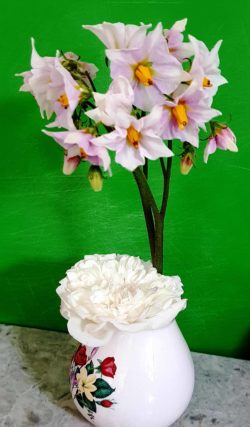 alarming shade of fuchsia as a teenager. He has happily clung to it as only a British guy can) the real joy was developing a vegetable garden. With a terrace garden that had been neglected for years, he first dug up and created new raised beds for potatoes – something that is not a tradition where I live in Virginia. Their blossoms are beautiful. He recently wrote: “Lockdown came upon us all with many stories of the good, bad and the ugly of human nature, but overwhelmingly of how we strive to survive and make do with what we have and very thankful for WHOM we have with us.” He cleaned, restored and kitted out the garden shed and flew a pirate flag to complete the look. His father-in-law is hopeful that he will have time to fix the broken-down deck so that we can have cocktails overlooking their remarkable view of Winchester and beyond, once the current unpleasantness passes.
alarming shade of fuchsia as a teenager. He has happily clung to it as only a British guy can) the real joy was developing a vegetable garden. With a terrace garden that had been neglected for years, he first dug up and created new raised beds for potatoes – something that is not a tradition where I live in Virginia. Their blossoms are beautiful. He recently wrote: “Lockdown came upon us all with many stories of the good, bad and the ugly of human nature, but overwhelmingly of how we strive to survive and make do with what we have and very thankful for WHOM we have with us.” He cleaned, restored and kitted out the garden shed and flew a pirate flag to complete the look. His father-in-law is hopeful that he will have time to fix the broken-down deck so that we can have cocktails overlooking their remarkable view of Winchester and beyond, once the current unpleasantness passes.
A Man Of The Fens
 Pinky’s grandfather was a farmer in Norfolk who had been wounded in the Battle Of The Somme in WW1 and became an Air Warden in WW2. He returned to farming after both wars. He farmed in the famed flat coastal area in the east of England, which is referred to as The Fens. Pinky has never forgotten his times with his grandfather on his farm, where there were chickens, crops of onions, potatoes and carrots, along with fruit orchards. His grandparents produced milk, butter, cheese, and sugar beet for local shops, all of which were organic. All the labor was manual until his grandparents could afford a tractor. The work was hard and relentless. Having observed his grandfather, Pinky first planted the sacred British potatoes. When it was raining (not being on the plain in Spain) he started the packs of tomato and chili pepper seeds, plus seedlings for bell peppers, lettuce, carrots, cucumbers and some onions. He filled their little side conservatory with them and put together a glass lean-to for seedlings so that they could survive through the early months of spring. With lots of watering, he successfully grew thirty Roma tomato plants, five chili plants, and two bell pepper plants. His only failure was that none of the onions survived.
Pinky’s grandfather was a farmer in Norfolk who had been wounded in the Battle Of The Somme in WW1 and became an Air Warden in WW2. He returned to farming after both wars. He farmed in the famed flat coastal area in the east of England, which is referred to as The Fens. Pinky has never forgotten his times with his grandfather on his farm, where there were chickens, crops of onions, potatoes and carrots, along with fruit orchards. His grandparents produced milk, butter, cheese, and sugar beet for local shops, all of which were organic. All the labor was manual until his grandparents could afford a tractor. The work was hard and relentless. Having observed his grandfather, Pinky first planted the sacred British potatoes. When it was raining (not being on the plain in Spain) he started the packs of tomato and chili pepper seeds, plus seedlings for bell peppers, lettuce, carrots, cucumbers and some onions. He filled their little side conservatory with them and put together a glass lean-to for seedlings so that they could survive through the early months of spring. With lots of watering, he successfully grew thirty Roma tomato plants, five chili plants, and two bell pepper plants. His only failure was that none of the onions survived.
August Without Zucchini
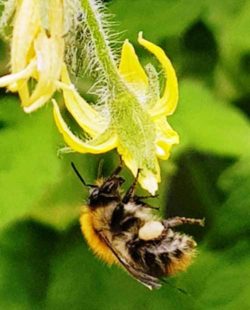 The resulting bonanza in August was astounding, and even after sharing produce with local friends, Pinky could not bear to see his hard-earned bounty go to waste, particularly in this pandemic. He remembered stories from his mother (and her own pantry filled with pickled and canned foods) about wartime England, where anything that could be grown and not eaten immediately was preserved for a later meal. With that in mind and the new scary landscape facing all of us, Pinky planned his own Pickle For England! campaign. He used saved jam and mayonnaise jars, and purchased additional new smaller sizes. After sterilizing jars in the oven and boiling the lids, he filled them with hot preserve, processed them properly and successfully popped all the lid
The resulting bonanza in August was astounding, and even after sharing produce with local friends, Pinky could not bear to see his hard-earned bounty go to waste, particularly in this pandemic. He remembered stories from his mother (and her own pantry filled with pickled and canned foods) about wartime England, where anything that could be grown and not eaten immediately was preserved for a later meal. With that in mind and the new scary landscape facing all of us, Pinky planned his own Pickle For England! campaign. He used saved jam and mayonnaise jars, and purchased additional new smaller sizes. After sterilizing jars in the oven and boiling the lids, he filled them with hot preserve, processed them properly and successfully popped all the lid s (which signals the vacuum seal as the jars cool). He now has green tomato chutney, frozen tomato pasta sauce, sundried tomatoes in olive oil, green tomato salsa, 150 dried chiles that have been pickled or added to chutney. And pickled cucumbers. Upon discovering and caring for the thriving elderberry and blueberry bushes, he has tried his hand at creating elderberry wine and blueberry vodka plus an experimental strawberry grappa from his discovery of these fruit-bearing plants. He has sent me some of his most successful recipes from this Pandemic Garden. I am sure his grandfather would have appreciated this small treasured spot of England.
s (which signals the vacuum seal as the jars cool). He now has green tomato chutney, frozen tomato pasta sauce, sundried tomatoes in olive oil, green tomato salsa, 150 dried chiles that have been pickled or added to chutney. And pickled cucumbers. Upon discovering and caring for the thriving elderberry and blueberry bushes, he has tried his hand at creating elderberry wine and blueberry vodka plus an experimental strawberry grappa from his discovery of these fruit-bearing plants. He has sent me some of his most successful recipes from this Pandemic Garden. I am sure his grandfather would have appreciated this small treasured spot of England.
Last Minute Preserve Shopping
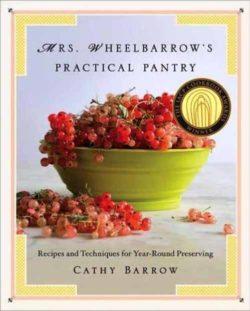 Our farm stand markets are filled with preserving possibilities – some with bushel pricing and also “second
Our farm stand markets are filled with preserving possibilities – some with bushel pricing and also “second 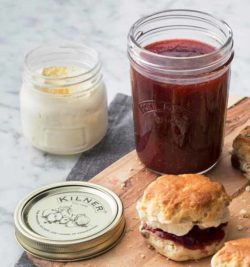 quality” produce – which are still dandy for canning, or freezing. Before you embark on your preserving adventure, arm yourself with some knowledge. If you are not familiar with Cathy Barrow, a local waste-not- want-not advocate of preserving – check out her website. I have her book on preserving and it is excellent – written so that you easily understand the dos and don’ts, plus good recipes to get you started. She also includes Instructions for curing meats in your home – but that’s another story. Secondly, I like my jars to look inviting, and with no offense to Ball or Mason Jars, which are now promoted to hold drinks as well as tomatoes, I really prefer jars from Leifheit in Germany and Kilner in the UK. Both companies offer a wide range of designs and replacement lids. I am hoping Pinky’s grandmother would approve.
quality” produce – which are still dandy for canning, or freezing. Before you embark on your preserving adventure, arm yourself with some knowledge. If you are not familiar with Cathy Barrow, a local waste-not- want-not advocate of preserving – check out her website. I have her book on preserving and it is excellent – written so that you easily understand the dos and don’ts, plus good recipes to get you started. She also includes Instructions for curing meats in your home – but that’s another story. Secondly, I like my jars to look inviting, and with no offense to Ball or Mason Jars, which are now promoted to hold drinks as well as tomatoes, I really prefer jars from Leifheit in Germany and Kilner in the UK. Both companies offer a wide range of designs and replacement lids. I am hoping Pinky’s grandmother would approve.
N.B. The Secret Garden is a marvelous book that I read when I was about 11 years old. It is about self discovery and the wonder of Nature, even when  neglected. *The quote
neglected. *The quote 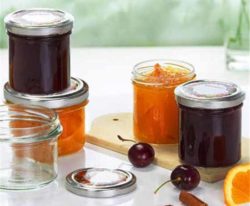 “Might I have a bit of earth” was Mary Lennox’s question to her unhappy and ill guardian when she meets him for the first time. The two recipes below and this link to creating your own fruit based wines – which is much longer, so read through it a few times – are all from Pinky. He researched and worked with several procedures and recipes and chose these three as his favorites for his unexpected bounty. I have included a link about how to make a pickling vinegar which is used in the UK and is tastier than the store-bought versions available here.
“Might I have a bit of earth” was Mary Lennox’s question to her unhappy and ill guardian when she meets him for the first time. The two recipes below and this link to creating your own fruit based wines – which is much longer, so read through it a few times – are all from Pinky. He researched and worked with several procedures and recipes and chose these three as his favorites for his unexpected bounty. I have included a link about how to make a pickling vinegar which is used in the UK and is tastier than the store-bought versions available here.
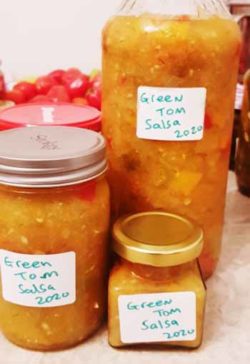

- 5 lbs (2 1/4kg) green tomatoes, chopped small for salsa
- 6 yellow onions chopped to the same size as the tomatoes
- 3 jalapeno peppers with seeds, chopped - about 1/2 cup or 118ml
- 2 large red bell peppers chopped to the same size for salsa
- 6 garlic cloves minced
- 1 cup (237ml)chopped fresh cilantro
- 1 cup (237ml)lime juice
- 1/2 cup (118ml) vinegar - cider vinegar is a good choice
- 1 tablespoon salt
- 1 tablespoon dried oregano leaves
- 1/2 tablespoon cumin
- 2 teaspoons pepper - ground white pepper is preferred
- 1/4 teaspoon cayenne (optional to taste)
- 1-2 teaspoons sugar
- Combine all ingredients in a large pot, mixing well. Bring pot to boil, reduce heat to simmer and cook for 30-40 minutes, stirring occastionally.
- Bring salsa to a boil.
- Bring a canning pot to a boil, and reserve.
- Ladle salsa into hot sterile jars, leaving 1/2 inch headspace.
- Wipe lids and jar edges clean before tightening lids onto jars and placing them back to a boiling canning pot.
- Process the jars for 15 minutes in the canning pot.
- Remove carefully and let sit for 24 hours. Check lids for seal, and it there are any that have not sealed correctly, refrigerate those and use within the month.
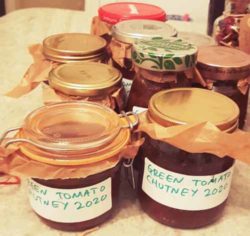

- 2½ kg (4.4lb) green tomatoes
- 500gr (1 1/8lb) yellow onions
- 1 rounded tbsp salt
- 500gr (1 1/8lb)sultanas
- 500gr (1 1/8lb)cooking apples
- 500gr (1 1/8lb)light muscovado sugar
- 1.14l (1 1/3qt) jar spiced pickling vinegar
- Slice the tomatoes (you can skin them if you want, but it's not necessary).
- Finely chop the onions and layer both in a large bowl with the salt.
- Leave overnight before proceeding with next steps.
- The next day, chop the sultanas using a large, sharp knife, then peel, core and chop the apples. Put the sugar and vinegar into a large pan and bring to the boil, stirring to dissolve the sugar.
- Add the sultanas and apples and simmer for 10 mins.
- Strain the tomatoes and onions in a colander (but don’t rinse), then tip into the pan and return to the boil.
- Simmer for about 1 hr, stirring occasionally until the mixture is thick and pulpy. Transfer to warmed jars (see tips, below) and cover with lids.
- See link in post about pickling vinegar.
- You can use old jam jars for chutney as long as the inside of the lids are plastic coated, otherwise the vinegar will corrode the metal.The author prefers the KIlner jars. To sterilise, wash the jars in very hot water and leave to drain. When they are dry, put them in the oven at 160C/325F for 10 mins before using
- What helps preserve the chutney?
- The acidity (low pH) of the chutney prevents growth of several spoilage and pathogenic bacteria, molds and yeasts. This acidity is derived from the added vinegar and the natural acids of the fruit.
- Cooking the mixture to concentrate it lowers available moisture that is needed for microbial growth. The cooking step also kills most microorganisms that may be present.
- Processing the filled jars in a canner uses additional heat to kill spoilage organisms that might contaminate the product as jars are filled and to produce a vacuum seal for later storage. If the two-piece canning lid is applied correctly, air is driven out of the headspace while the jars are in the canner and a vacuum seal is formed upon cooling. For most chutneys, a boiling water canning process is adequate, but other foods may require a pressure process.
- During storage in the sealed jar, oxygen and additional microbial contamination is kept from the product. Too much oxygen left in the jar will cause interactions with food compo
.

Kitchen Detail shares under the radar recipes, explores the art of cooking, the stories behind food, and the tools that bring it all together, while uncovering the social, political, and environmental truths that shape our culinary world.




I was gifted one of your copper preserving pans back in the 1990’s, and until today, have kept it busy. In the last few years, I discovered a book that changed my preserving life. The title is The Blue Chair Jam Cookbook by Rachel Saunders. Not only has Rachel revolutionized the process of sterilizing and sealing (using an oven) rather than the miserable hot water bath, she is a purist about her recipes…Nancy, if you don’t know this book, own it. For years I made dozens of jars of chutneys, jams, preserves, conserves using the copper pan from your store.… Read more »
Hello Diane,
How lovely to hear from you! I still have my preserving pan in the 109 boxes waiting to come over to Italy. I don’t have that book, so I am going to see if I can get at least an E version of it. There are some preserves, I think I still want to make. Thank you also for the heartfelt words about the La Cuisine. It means a lot to me.
Nancy